Art
The Contested Art of ‘Surviving Vancouver’
Take the painting above by local artist and heritage advocate Michael Kluckner. Completed in the year 2000, he thought he was capturing the final days of the Sunrise Market in the West End.
Rising up behind it on Robson Street was the Empire Landmark Hotel. When it was completed in 1973, it was the tallest of its kind, a herald of the growth that the city would experience in the coming years. The hotel even boasted one of those revolving restaurants that every city, surely, needs to be world class.
But fast-forward to the present. That little shopfront that housed the Sunrise is still here, now the beloved Cardero Cafe.
As for the Empire Landmark? In 2018, its demolition began, once again breaking a record: it was the tallest building to be taken down in the city’s history. A new development with the same name is coming soon.
“It’s ironic. The Landmark really was a landmark,” said Kluckner of the painting that graces the cover of his newest book, Surviving Vancouver.
The pressures represented in the image have only continued to build up as the city has. It’s been almost four decades since the development — and demolition — boom around Expo 86 led to an interest in his works that capture the beauty and stillness of a Vancouver moment before it vanishes. Surviving Vancouver comes exactly 40 years after Kluckner published his book Vancouver the Way It Was.
“In ’88, I’d look for language in Real Estate Weekly that said that this building was to be bulldozed. ‘Attention, builders,’ it would say,” said Kluckner. “And I’d think, ‘Hmm, what’s this? That’s kind of interesting.’ So I began to explore the neighbourhoods and see things that looked like they were about to be torn down and I started painting them…. And that really took me from being a popular historian guy with a book like Vancouver the Way It Was to becoming a bit of a fire breather and activist on heritage preservation — this whole thing of: what is the character of the city? Is it only views? Or is it actually a place where we live?”
Many of the book’s works feature familiar glimpses of built history like the corner store and the hotel tower, from the first skyscrapers of a burgeoning city to the famous manors of the city’s elite to the picturesque neighbourhoods that sustained family lives before their humble houses took on multimillion-dollar price tags.
Vancouver has never looked so dreamy in watercolour, especially as Kluckner paints the seasons: spring clouds over the harbour, summer light in tree canopies, autumn leaves in sidewalk puddles, a winter walk through the snow to a grocer on Commercial Drive.
“You could almost call me a romantic landscape painter; I just love painting the weather,” he said.
But Kluckner is interested in much more than esthetics.
“On the other side, I’m still just a 25-year-old cartoonist.”
There are pictures in the book that look like they could be political cartoons but are real, like a window display at the Bay with the tag line “The Spring Forecast Calls for Style,” with a figure curled up in a sleeping bag in front of the well-dressed mannequins.
Readers are invited to ponder two questions with Kluckner’s scenes of the city, some of which no longer exist or have evolved. What’s survived in Vancouver? And how do you survive in Vancouver?
While the watercolours are a highlight, Surviving Vancouver is an engaging historical scrapbook that readers will get lost in as they explore these two questions.
“Neighbourhoods are changing with everything to do with zoning, land speculation and other tensors,” said Kluckner. Even in the quietest of his pictures, you can feel the pressures of change. In one painting of Shaughnessy, a mansion sits in wait, empty, boarded and graffitied.
“Old people like me who got into [the city] early, we’re just coasting along. What happens after? What’s surviving going to look like?”
In the introduction, a series of bird’s-eye-view maps show a landscape once home to Indigenous Peoples carved up by settlers, from mills to military reserves to railway lands, and shaped into today’s Metro Vancouver.
Contested space is a big theme of this place, says Kluckner, and his writing tells the stories behind the art, unpacking the politics and power players that have made and unmade pockets of the region, from the creation of Shaughnessy to the rise of the so-called Amazing Brentwood — the towers of which are done in ink, not deserving watercolours.
While there are a lot of buildings, Kluckner never forgets the people. Among the survivors are street vendors, people living in their RVs during the pandemic and binners, collecting and refunding recyclables to make ends meet. Many of them pop up across the pages so that readers don’t forget them either.
Sprinkled throughout are also newspaper clippings, with characters that will be surprising to the Vancouverites of today, like wartime squatters leaving the waterfront with violins in tow, and headlines of the past that are no different from those of today, like one from the 1980s telling of demovicted renters.
It’s a lot of weighty history, but Kluckner showcases the delights that make people love Vancouver so much, whether it’s the familiar sight of waves in the wake of a ferry or the vendors on Robson Street.
Here is a sampling of Kluckner’s city sights that tell stories of survival.
The Birks clock
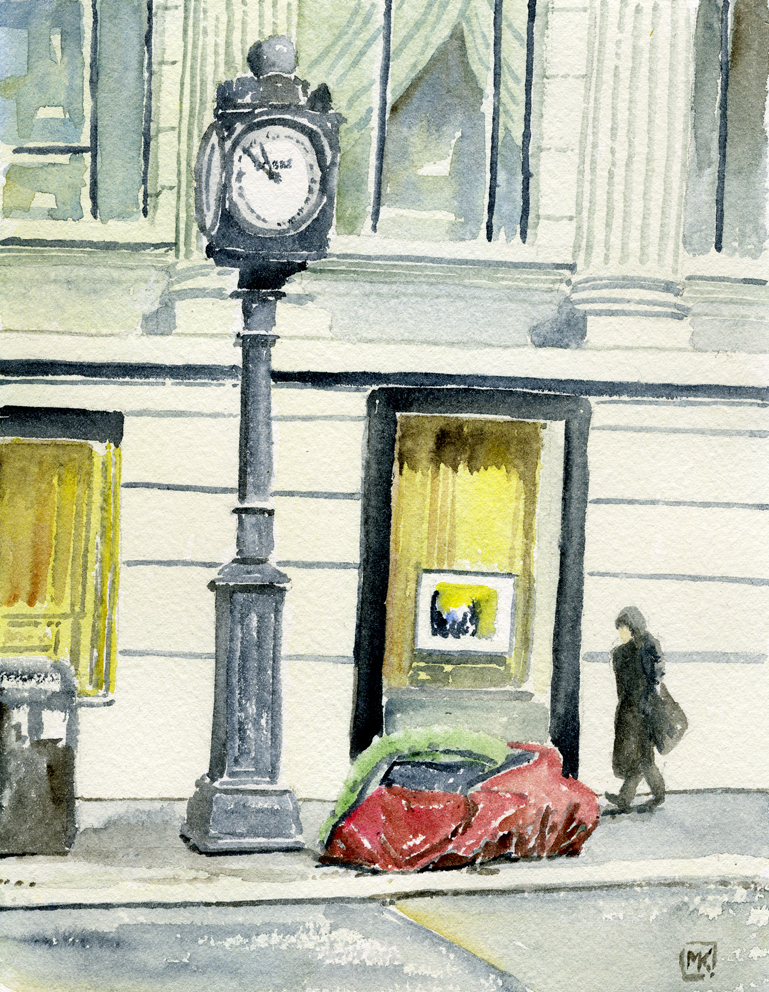
Owned by the jewelry retailer Birks, the memorable clock has moved a number of times since it was built in 1906. For decades, it was the recognizable downtown landmark near which meetings were arranged in the era before cellphones. Its current location is at Hastings and Granville, moved there in 2010 for the Winter Olympics.
“Birks and its clock are still there, elegant jewelry and art displayed in its window, but there is a tent pitched at the base of the clock,” writes Kluckner in the book. “From the tent comes moaning and shouting — a man crying out in a mental-health crisis. He can be heard from a block away, but there is no one to help. People walk by. It’s become normal.”
The Jeffs Residence
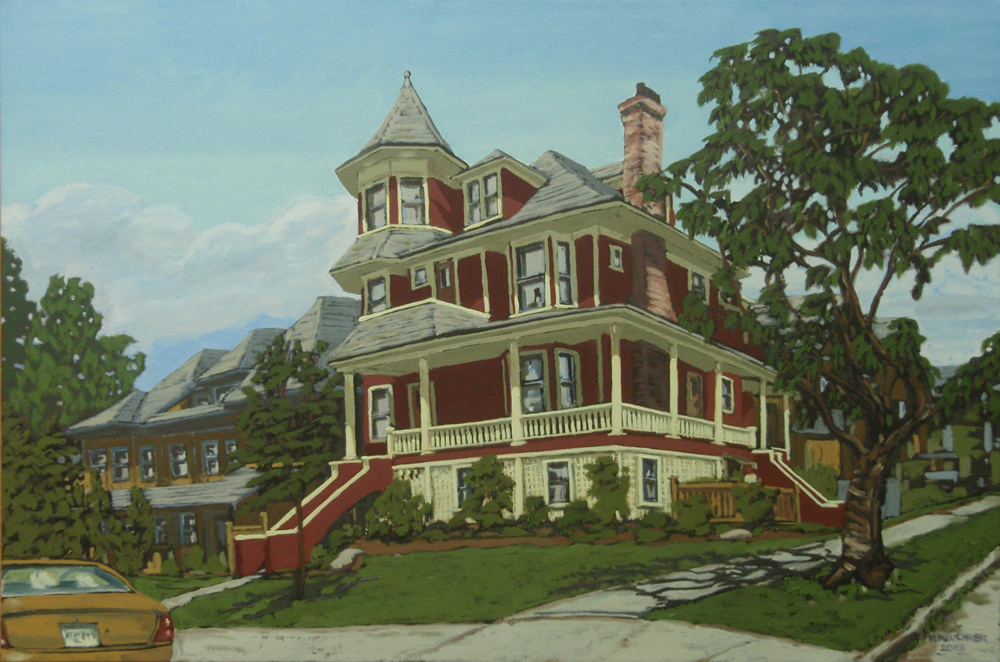
Completed in 1908, the sprawling 3 1/2-storey house on the corner of Salsbury Drive and Charles Street was the home of Dr. Thomas William Jeffs, the city’s coroner. The house still stands and it’s got more people on the property than ever before, a testament of how buildings evolve to fit the needs of the city today.
“James Evans, he’s the builder who’s done these projects: taken a big old house, converting it into units, and then he’s infilled them,” said Kluckner. “[Jeffs] is a huge success, a little community of townhouses with everything. In the neighbourhood, you can hear the people who have set up there. Babies being born. People sharing babysitters. All that sort of community. I think that’s so important.”
The Balmoral Hotel
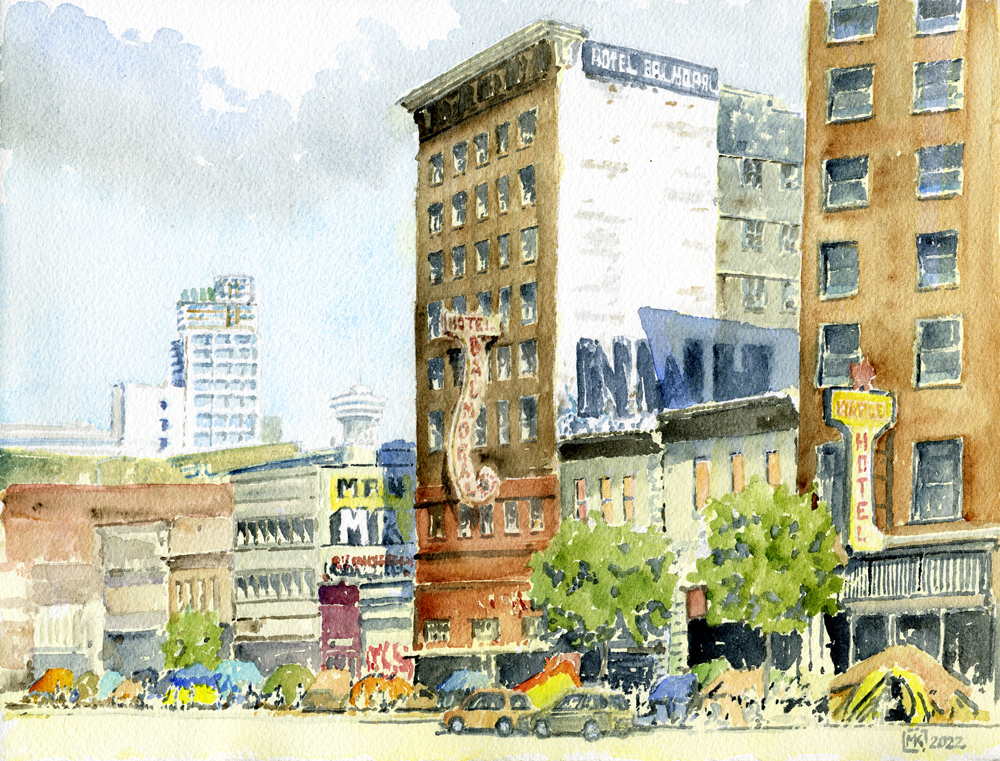
It was built in 1912, when Vancouver, at the end of the railway, staked its claim as the province’s hub of finance, manufacturing and shopping.
The Sahota family eventually bought the property, which functioned as a “single-room occupancy” of small rental homes, and allowed it to fall into disrepair. The city expropriated the decrepit building in 2020, with demolition underway in phases.
“I went by there on the bus the other day and it’s down to about that level,” said Kluckner, pointing to about halfway of the building’s height.
It was a landmark of the city’s prosperity, but would become a landmark of the struggles of the Downtown Eastside neighbourhood. Kluckner painted the icon for the book as it looked in recent memory, before its final days.
The city disposed of the neon sign as part of the demolition, claiming that it was “not possible to salvage or restore” it.
Pay phones, menus, newspapers
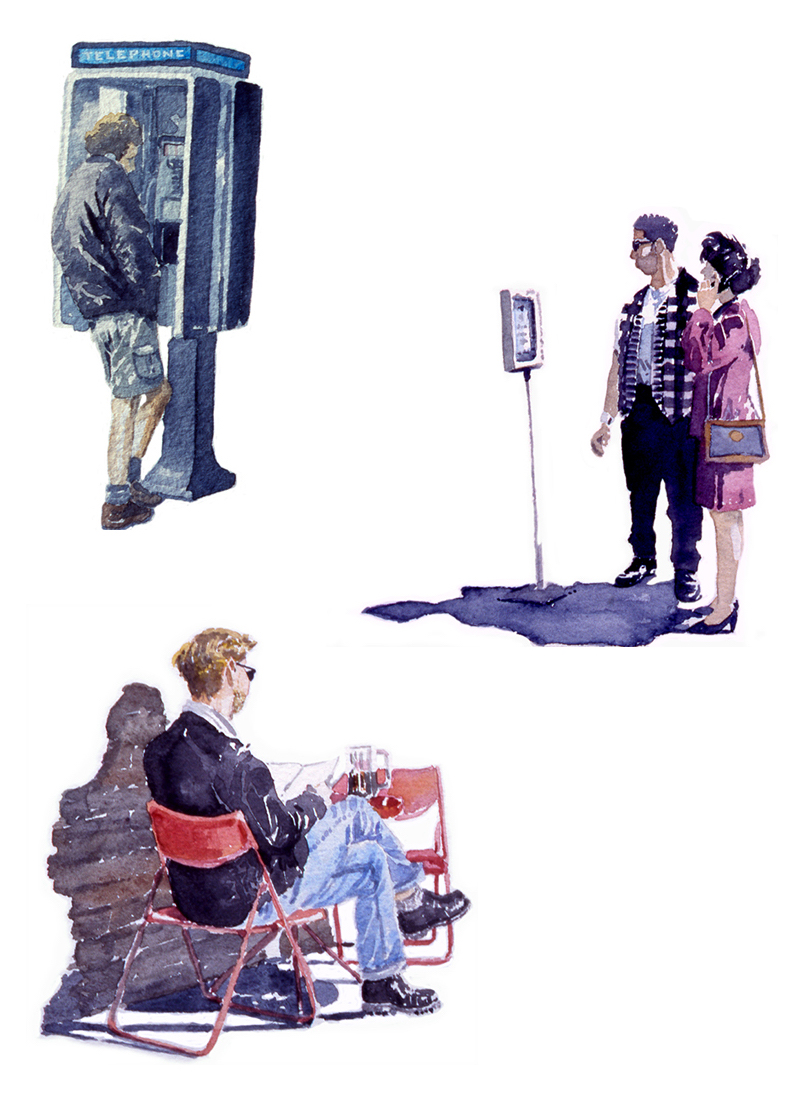
Kluckner has included some watercolour sketches of Vancouverites in the 1990s, making calls, deciding what to eat, reading the headlines of the day.
You’d be hard pressed to find a phone booth today and many newspaper bins have vanished. Physical menus are currently doing battle with QR codes.
Some of these sketches appeared in his 1996 book. The fashion and accessories tell you how much things have changed.
“There was only one vignette of a person on a cellphone,” recalled Kluckner.
Ancient trees
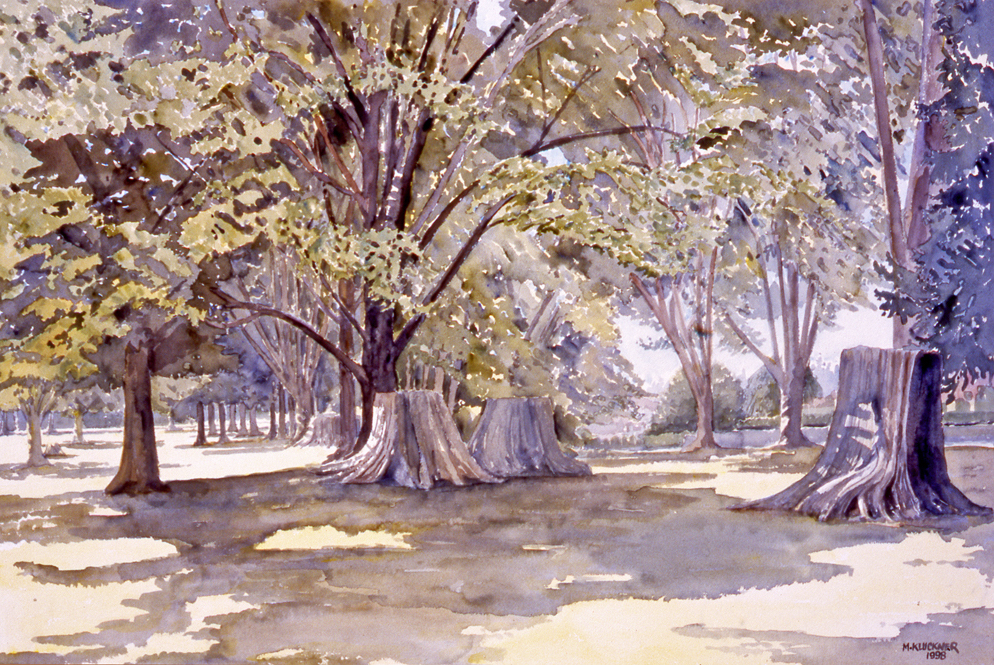
Apart from built history, Kluckner also captures Vancouver’s natural history before colonization.
With climate change and the lingering fear of heat domes like 2021’s, cool shade like that of the scene above means all the more in paved cities.
“The stumps of ancient trees were left in Maple Grove Park in Kerrisdale more than a century ago in a rare (for the time) acknowledgment,” he writes, “that there was anything here before.” ![]()

Art
Calvin Lucyshyn: Vancouver Island Art Dealer Faces Fraud Charges After Police Seize Millions in Artwork

In a case that has sent shockwaves through the Vancouver Island art community, a local art dealer has been charged with one count of fraud over $5,000. Calvin Lucyshyn, the former operator of the now-closed Winchester Galleries in Oak Bay, faces the charge after police seized hundreds of artworks, valued in the tens of millions of dollars, from various storage sites in the Greater Victoria area.
Alleged Fraud Scheme
Police allege that Lucyshyn had been taking valuable art from members of the public under the guise of appraising or consigning the pieces for sale, only to cut off all communication with the owners. This investigation began in April 2022, when police received a complaint from an individual who had provided four paintings to Lucyshyn, including three works by renowned British Columbia artist Emily Carr, and had not received any updates on their sale.
Further investigation by the Saanich Police Department revealed that this was not an isolated incident. Detectives found other alleged victims who had similar experiences with Winchester Galleries, leading police to execute search warrants at three separate storage locations across Greater Victoria.
Massive Seizure of Artworks
In what has become one of the largest art fraud investigations in recent Canadian history, authorities seized approximately 1,100 pieces of art, including more than 600 pieces from a storage site in Saanich, over 300 in Langford, and more than 100 in Oak Bay. Some of the more valuable pieces, according to police, were estimated to be worth $85,000 each.
Lucyshyn was arrested on April 21, 2022, but was later released from custody. In May 2024, a fraud charge was formally laid against him.
Artwork Returned, but Some Remain Unclaimed
In a statement released on Monday, the Saanich Police Department confirmed that 1,050 of the seized artworks have been returned to their rightful owners. However, several pieces remain unclaimed, and police continue their efforts to track down the owners of these works.
Court Proceedings Ongoing
The criminal charge against Lucyshyn has not yet been tested in court, and he has publicly stated his intention to defend himself against any pending allegations. His next court appearance is scheduled for September 10, 2024.
Impact on the Local Art Community
The news of Lucyshyn’s alleged fraud has deeply affected Vancouver Island’s art community, particularly collectors, galleries, and artists who may have been impacted by the gallery’s operations. With high-value pieces from artists like Emily Carr involved, the case underscores the vulnerabilities that can exist in art transactions.
For many art collectors, the investigation has raised concerns about the potential for fraud in the art world, particularly when it comes to dealing with private galleries and dealers. The seizure of such a vast collection of artworks has also led to questions about the management and oversight of valuable art pieces, as well as the importance of transparency and trust in the industry.
As the case continues to unfold in court, it will likely serve as a cautionary tale for collectors and galleries alike, highlighting the need for due diligence in the sale and appraisal of high-value artworks.
While much of the seized artwork has been returned, the full scale of the alleged fraud is still being unraveled. Lucyshyn’s upcoming court appearances will be closely watched, not only by the legal community but also by the wider art world, as it navigates the fallout from one of Canada’s most significant art fraud cases in recent memory.
Art collectors and individuals who believe they may have been affected by this case are encouraged to contact the Saanich Police Department to inquire about any unclaimed pieces. Additionally, the case serves as a reminder for anyone involved in high-value art transactions to work with reputable dealers and to keep thorough documentation of all transactions.
As with any investment, whether in art or other ventures, it is crucial to be cautious and informed. Art fraud can devastate personal collections and finances, but by taking steps to verify authenticity, provenance, and the reputation of dealers, collectors can help safeguard their valuable pieces.
Art
Ukrainian sells art in Essex while stuck in a warzone – BBC.com
[unable to retrieve full-text content]
Ukrainian sells art in Essex while stuck in a warzone BBC.com

Source link
Art
Somerset House Fire: Courtauld Gallery Reopens, Rest of Landmark Closed
The Courtauld Gallery at Somerset House has reopened its doors to the public after a fire swept through the historic building in central London. While the gallery has resumed operations, the rest of the iconic site remains closed “until further notice.”
On Saturday, approximately 125 firefighters were called to the scene to battle the blaze, which sent smoke billowing across the city. Fortunately, the fire occurred in a part of the building not housing valuable artworks, and no injuries were reported. Authorities are still investigating the cause of the fire.
Despite the disruption, art lovers queued outside the gallery before it reopened at 10:00 BST on Sunday. One visitor expressed his relief, saying, “I was sad to see the fire, but I’m relieved the art is safe.”
The Clark family, visiting London from Washington state, USA, had a unique perspective on the incident. While sightseeing on the London Eye, they watched as firefighters tackled the flames. Paul Clark, accompanied by his wife Jiorgia and their four children, shared their concern for the safety of the artwork inside Somerset House. “It was sad to see,” Mr. Clark told the BBC. As a fan of Vincent Van Gogh, he was particularly relieved to learn that the painter’s famous Self-Portrait with Bandaged Ear had not been affected by the fire.
Blaze in the West Wing
The fire broke out around midday on Saturday in the west wing of Somerset House, a section of the building primarily used for offices and storage. Jonathan Reekie, director of Somerset House Trust, assured the public that “no valuable artefacts or artworks” were located in that part of the building. By Sunday, fire engines were still stationed outside as investigations into the fire’s origin continued.
About Somerset House
Located on the Strand in central London, Somerset House is a prominent arts venue with a rich history dating back to the Georgian era. Built on the site of a former Tudor palace, the complex is known for its iconic courtyard and is home to the Courtauld Gallery. The gallery houses a prestigious collection from the Samuel Courtauld Trust, showcasing masterpieces from the Middle Ages to the 20th century. Among the notable works are pieces by impressionist legends such as Edouard Manet, Claude Monet, Paul Cézanne, and Vincent Van Gogh.
Somerset House regularly hosts cultural exhibitions and public events, including its popular winter ice skating sessions in the courtyard. However, for now, the venue remains partially closed as authorities ensure the safety of the site following the fire.
Art lovers and the Somerset House community can take solace in knowing that the invaluable collection remains unharmed, and the Courtauld Gallery continues to welcome visitors, offering a reprieve amid the disruption.
-

 Politics16 hours ago
Politics16 hours agoNew Brunswick Premier Blaine Higgs expected to call provincial election today
-
Media15 hours ago
Sutherland House Experts Book Publishing Launches To Empower Quiet Experts
-

 Sports11 hours ago
Sports11 hours agoArch Manning to get first start for No. 1 Texas as Ewers continues recovery from abdomen strain
-

 Investment14 hours ago
Investment14 hours agoCanada’s Probate Laws: What You Need to Know about Estate Planning in 2024
-

 Politics14 hours ago
Politics14 hours agoNew Brunswick Premier Blaine Higgs kicks off provincial election campaign
-

 News16 hours ago
News16 hours agoQuebec won’t fund graphite mine project tied to Pentagon; locals claim ‘victory’
-

 Sports11 hours ago
Sports11 hours agoFormer Canada captain Atiba Hutchinson tells his story in ‘The Beautiful Dream”
-

 Politics10 hours ago
Politics10 hours agoNew Brunswick election profile: Progressive Conservative Leader Blaine Higgs

















